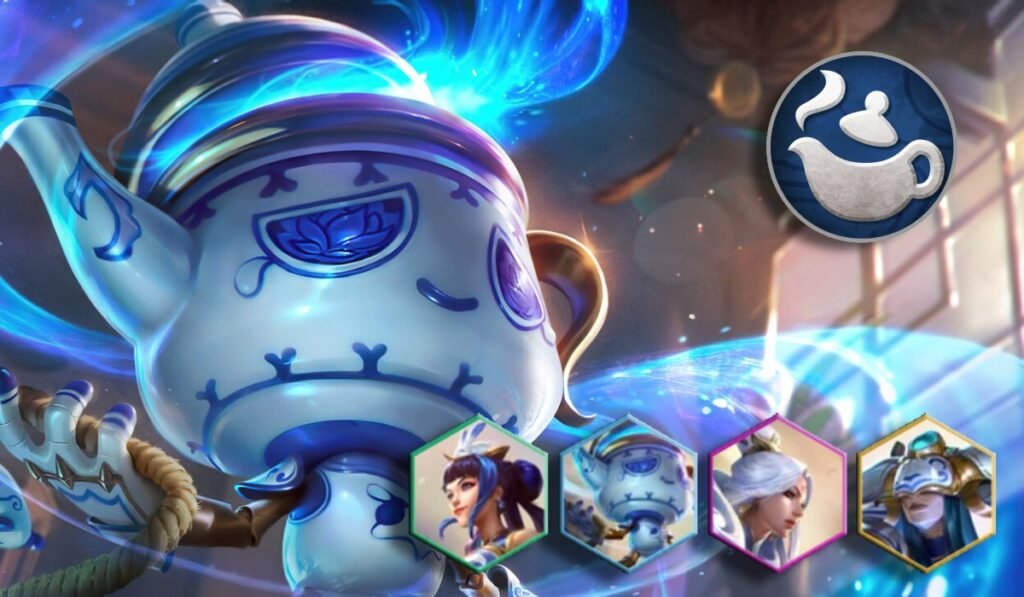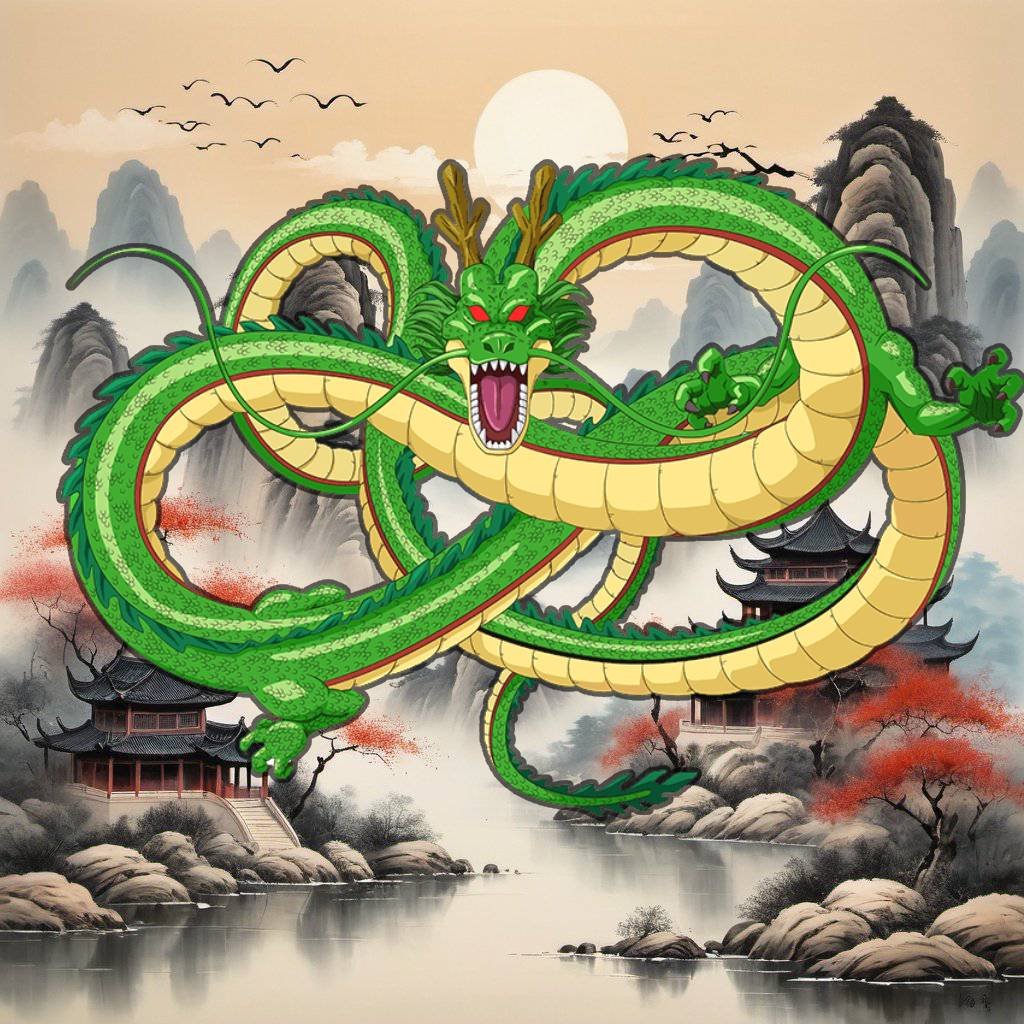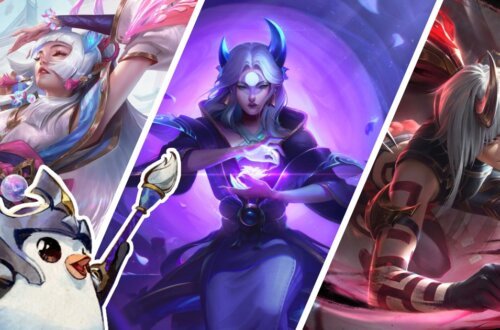
TFT Set 11: The Fascinating Lore in Inkborn Fables (2/4)
Riot Games released TFT Set 11: Inkborn Fables in March 2024, shortly after League of Legends’s annual Lunar New Year event ended.
They took the opportunity to extend the revelry just a little further with a TFT set filled to the brim with references to Chinese and generally East Asian mythology and history.
As an enthusiast of Asian culture, I felt like a hyperinsulinemic kid in a candy store. I couldn’t keep myself from unwrapping those sweet bits of miscellaneous knowledge!
Our first Inkborn Fables article examined the lore behind Mythic, Heavenly, and Storyweaver.
Now, we’re turning our attention to Porcelain, Fortune, and Dragonlord.
Bring out the fine china, pour yourself warm tea, and burn incense to invite good fortune as we discover the rich history behind TFT Set 11.
Porcelain

Are you old enough to remember Jackie Chan Adventures?
Jackie Chan Adventures and the Chinese Zodiac
This early-2000s cartoon followed martial artist and archaeologist Jackie Chan and his (fictional) niece, Jade, on a quest to retrieve powerful ancient artifacts and relics.
The main set of relics consisted of 12 magic talismans matching each sign of the Chinese Zodiac: Rat, Ox, Tiger, Rabbit, Dragon, Snake, Horse, Goat, Monkey, Rooster, Dog, and Pig.
Note: This is the official order of the Chinese Zodiac cycle. According to one legend, the order was determined through a race. How an Ox beat a flying Dragon is beyond me.

These talismans held ancient arcane powers that would be transferred to the wielder, such as telekinesis (Rooster), hyperspeed (Rabbit), and superstrength (Ox).
Of course, the main villain (evil reptilian sorcerer Shendu) sought to collect all talismans and ascend to godhood with their power.
What Does the Porcelain Trait Have to Do With Jackie Chan?
The plot of Jackie Chan Adventures perfectly matches the lore behind the Lunar Revel: Porcelain skins on Porcelain units in TFT Set 11.
Just replace “talismans” with “porcelain artifacts,” Jackie Chan and Jade with Ezreal and Lux, and evil reptilian sorcerer Shendu with evil snake sorceress Lissandra.

In case you were curious about each Porcelain unit’s relationship with the zodiac:
- Amumu is the guardian of the Rat Relic, which keeps him eternally young.
- Lux is the Rabbit Relic’s guardian and the protectors’ leader.
- Lissandra wields the Snake Relic and seeks ultimate power.
- Ashe isn’t in the Porcelain universe, so she uses a white-and-blue chroma of her Lunar Empress skin. At least it’s topical!
The Chinese Zodiac works similarly to the Western idea of zodiac signs in that your “sign” determines several things about your life and personality.
One of the main differences is that your sign in the Chinese Zodiac is determined by the year you were born instead of the month.
Note: I was born in the year of the Dog (1994). The zodiac describes us as loyal and a little anxious. Honestly, it adds up. Bark bark.

The lore behind the Porcelain skin line is fascinating. It also gives us an inkling as to why Riot thought Porcelain skins fit nicely with the East Asian mythology theme in TFT Set 11.
Still, that doesn’t explain why they even connected porcelain with the Chinese Zodiac in the first place.
It can’t be just because it looks nice. After all, it’s the “Porcelain” trait, not the “Horoscope” trait.
How exactly does Porcelain count as an Inkborn Fable?
As you might have guessed by now, the answer lies in Chinese history.
Why The Story of Porcelain is an Inkborn Fable
Porcelain entered Western markets around the 17th Century. It’s kind of a novelty on this side of the world.
On the other hand, the Chinese have been making glossy ceramics since the Shang dynasty (1600-1046 BCE). Although, technically, the people we’re talking about wouldn’t think of themselves as “Chinese” for another thousand years or so.
By the time of the Eastern Han dynasty (25-220 CE), porcelain had already become the gorgeous translucent material we know today.
Note: Porcelain’s Chinese origin is why pottery and tableware made of this material are known as “china” or “fine china” in some English-speaking countries.
Only one piece separates Han-period porcelain from the gorgeous teapot Lissandra uses to boil her victims: the blue highlights.

This recent development in porcelain’s history is a product of commercial and cultural exchange with the Middle East starting in the 8th Century.
Let’s summarize an incredibly complex process spanning hundreds of years into a few over-simplified lines:
- The Abbasid Caliphate established good relations with the Chinese Tang Dynasty, increasing trade from the 8th Century onward.
- Chinese porcelain made it to Abbasid lands (modern-day Iraq).
- Abbasid artisans imitated porcelain imports by developing tin-glazed white pottery. They decorated it with a cobalt blue tint.
- Abbasid pottery returned to China, along with word of the blue pigment. It inspired Chinese artisans to develop their own version with genuine porcelain.
- The Chinese started importing cobalt from Persia to make the blue pigment, now known as Islamic Blue (Huihui qing).
- During the late Yuan dynasty (1279-1368), Chinese blue-and-white porcelain became widespread and took over the homes of the rich and powerful.
You could say the “Islamic Blue” pigment puts the “Ink” in these porcelain Inkborn Fables.
Fortune

Bringing in good fortune by honoring the gods is a central theme in many Chinese festivals.
Sometimes, having “good fortune” is understood as earning the gods’ favor in all matters, including love and health. Other times, it’s just about material possessions.
In the case of the Fortune trait in TFT Set 11, it’s about increasing your Econ and improving your board.
Funnily, we can achieve both of these objectives in precisely the same way.
Chinese Money Trees: An Ancient Arts & Crafts Project
Putting 3+ Fortune units on your board will make a money tree pop up from the ground. As time passes (and you lose matches), the tree will give you rewards such as items, units, and money.
Once you’re at 7+ Fortune units, the tree becomes massive and pumps out ridiculous amounts of loot every turn. There’s nothing quite like it. It’s peak TFT.
In some parts of China, it’s customary to make similar “money trees” or “good luck trees” to decorate your home or business and bring good fortune.

These artisanal decorations resemble very valuable bonsai. The trunk and branches mimic precious metals (such as gold, silver, and copper), while yansheng coins or crystals hang in place of leaves.
Note: Another kind of “money tree” also said to bring in good fortune is the Pachira Aquatica, or Guiana Chestnut. Practitioners of Feng Shui believe it generates good chi (read: good vibes.).
According to archaeological records, creating money trees is nothing new. The tradition may have been popular among Chinese nobles over two thousand years ago. Early examples of money trees with similar characteristics have been found in tombs from the Han dynasty (25 – 220 CE).
But there’s more connecting the Fortune trait and the Lunar New Year than just the money tree.
Firecrackers: The Most Exciting Way to Ward Off Evil Spirits
The cosmetic skins chosen for Annie, Teemo, and Tristana come from the Lunar Revel: Firecracker line released during the Lunar New Year event for 2022.
These skins are based on the Chinese New Year celebrations themselves. They sport the staple red and gold colors, and their splash art and animations feature fireworks galore.

As with so many other things in life (porcelain included), firecrackers were first invented in China during the Tang Dynasty (618 – 907 CE). They later flourished during the Song dynasty (960 – 1279 CE).
Note: The idea of a loudly exploding cylinder dates from much earlier.
As far back as the Han dynasty (202 BC – 220 AD), the Chinese knew throwing bamboo stalks into the fire would make them explode (due to the building pressure of expanding air inside).
The Mandarin Chinese name for firecracker, “bào zhú,” literally means “exploding bamboo.”
They quickly became prevalent during celebrations. Nowadays, they’re a vital part of one of the leading “origin myths” for the Chinese New Year.
According to this story, a fearsome beast known as the nian would appear at the beginning of every year and terrorize villages by eating crops, livestock, and children.
Eventually, the villagers realized that the monster avoided loud noises and the color red.
From that moment, they began to lay out red decorations and detonate firecrackers at the beginning of every year. That way, the nian couldn’t come near the village, and peace returned.
Thus, a new tradition was born.
The fact that firecrackers and other fireworks are just so damn fun is merely a coincidence.
Dragonlord

But what if, instead of warding off evil spirits, the fireworks attracted good ones?
That’s the idea behind the Heavenscale skin line used for the Dragonlord units.
In the Heavenscale universe, the dragons reign over creation from a kingdom high above the clouds.
One day, the fireworks set off by humans (and yordles) to celebrate the New Year catch Dragon Prince Lee Sin’s eye. He wants to understand his subjects better, so he assumes a human form to enjoy the revelry.
China’s Ancient Obsession with Dragons
Dragons (long) have been ubiquitous in Chinese culture since time immemorial.
They were already culturally relevant for thousands of years before Qin Shi Huang established the first Chinese Empire in 221 BCE, so they predate “China” as a concept.

The earliest known examples of dragon-like idols in the region date back to Neolithic cultures. These include the Yangshao (5000-3000 BCE) and the Hongshan (4700 – 2900 BCE).
The figure of the dragon—including their significance and physical attributes—has significantly transformed since the Neolithic.
One of the most well-known classical depictions is the god of thunder, Shenlong, whose name means “dragon god.”
Others include Tianlong, Fuzanglong, Yinglong… It’s a very long list.
If the name Shenlong rings a bell, you’ve seen Goku summon the dragon god by collecting the seven Dragon Balls in Akira Toriyama’s famous manga.

Dragon Ball’s Shenlong is the perfect example of the average Chinese dragon. Common characteristics include:
- A long, serpent-like body covered in scales.
- Deer antlers.
- Demonic red eyes (sometimes described as rabbit eyes).
- Hawk-like claws.
- No wings (their flight is mystical/magical in nature).
Dragons as a Symbol of Ruling Power
Dragons reigning over mortals in the Heavenscale universe is coherent with Chinese mythology. After all, the dragon has been a sign of authority in China since ancient times.
More recently (read: when the Chinese Empire was established), the dragon became a symbol of imperial power.

Emperors would wear robes with dragon motifs, and their officials would carry dragon-shaped badges to show their authority.
The founder of the Han dynasty, Liu Bang, even claimed that his mother’s dragon dreams foretold his birth.
He’d have made great friends with the Targaryens from George R.R. Martin’s A Song of Ice and Fire.
When Dragons Mingle With Humankind
In Chinese lore, dragons are natural shapeshifters, able to disguise themselves as water, clouds, and even silkworms.
Stories of dragons taking on a human form (like Lee Sin) are less common, but they do exist.
And I don’t mean Jake Long from the American Dragon cartoon!
One of the most famous is the Story of Liu Yi, which follows a scholar who helps a dragon princess escape an abusive marriage. As a reward, she becomes a beautiful woman and marries Liu Yi.

This story, written by Li Chaowei during the Tang Dynasty (618 – 907 CE), is also known as The Tale of the Supernatural Marriage at Dongting (which spoils the ending).
A similar tale of a Dragon Princess falling in love with a government official exists in the 1766 literary anthology Strange Tales from a Chinese Studio by Pu Songling.
Note: The Pu Songling version was recently (2020) adapted into a Chinese fantasy film called The Eye of the Dragon Princess. It has an IMDb rating of 8.0, which warrants a watch.
Six Traits Down, Five More to Go
Our previous article covered the Mythical, Heavenly, and Storyweaver traits. It taught us a lot about Chinese mythology.
We just finished Porcelain, Fortune, and Dragonlords. Although mythology remained relevant, we focused more on Chinese history.
The following two articles will expand our horizons, focusing less on China alone and more on East Asia as a whole.
Click here to check out all four TFT Set 11 Lore articles.




